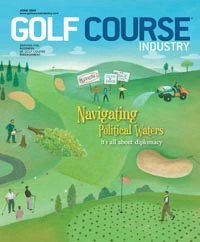In the historic home of golf, in the dramatic landscape of Scotland, the ceremonial gavel sounded to signal the beginning of my presidency of the American Society of Golf Course Architects. As I accepted the responsibility associated with leading this group for the coming year, I vowed to devote as much energy as I could to help the ASGCA familiarize the golf industry and general public with our members’ progressive messages – of which many revolve around water use and our views about environmentally responsible and sustainable practices in golf course development and remodeling. These messages can impact the game at every level, from player to pro. Golf course superintendents can keep these messages in mind when considering the goals of their architect associates.
The new Golden Age
Many players view the 1920s and much of the ’30s as the Golden Age of golf course architecture. Courses by such legends as Alister MacKenzie, Seth Raynor and Donald Ross are among the greatest examples of elemental design and are rightfully glorified. But now we’re in a revival period of great course design.
It can be argued that today’s practitioners have less optimal pieces of land to work with than their predecessors. Since the early 1990s, our generation’s architects have been producing some of the finest golf courses on some of the most challenging sites. By taking advantage of today’s technological advances and new theories about design, architects have created an exciting time in golf.
Water usage
Water is the lifeblood of every golf course. Many misconceptions linger around the ways in which golf courses use this resource. ASGCA members believe in doing more with less, and courses have begun to follow suit. ASGCA architects have been helping many courses reduce their annual overhead by strategically revamping their habitual water use.
At this year’s ASGCA annual meeting, members had the privilege of playing some of the most fabled courses in the history of golf, including The Old Course, Royal Dornoch and Turnberry. And it’s never been more apparent just how great a course can play when it simply echoes the watering practices, or lack thereof, of those legendary Scottish layouts. Club management and superintendents should allow their courses to play firm and fast. It’s a brand of golf that has been the norm for years at great courses worldwide and a concept many ASGCA members support.
ASGCA architects also are designing new courses and remodeling existing ones using improved technology, including drought-resistant grass varieties, and computer-monitored irrigation and root-moisture monitoring systems. Science has afforded architects the option of using recycled water resources. Effluent water is the only option for irrigation in many parts of the country, and its use is one way golf does its part to contribute to environmental sustainability.
Golf is green
There’s a saying that fits the times: “Golf is green, has been green and always will be green.” Unfortunately, some people outside the game adhere to dated beliefs that golf courses are bad for the environment, which isn’t true.
The fundamental nature of the game relies on thriving ecosystems ripe with beautiful, healthy landscapes and full of natural wildlife. As architects and ASGCA members, we do everything we can to maintain and enhance these intricate relationships. With the financial support of the ASGCA Foundation and the help of his fellow architects, ASGCA member and environmental committee chairman Bill Love recently completed the third edition of An Environmental Approach to Golf Course Development.
Love’s latest publication highlights positive ways in which golf courses maintain and rehabilitate the environment. The book includes 18 case studies from throughout North America and describes course projects that were situated on a variety of environmentally sensitive sites, including wetlands, wildlife habitats and abandoned areas once used for mining and landfills.
It’s ingrained in every ASGCA architect just how important it is to protect, enhance and preserve the environment in which we work and play. ASGCA members are in a unique position to help the golf industry recognize exactly what kind of progress is being made in new development projects and the new techniques that can be applied to future remodeling efforts. I hope you’ll join me in getting the word out that today’s golf design rivals that of the 1920s and ’30s and is an environmentally responsible steward of Mother Nature’s gifts. GCI
Bruce Charlton, president of the American Society of Golf Course Architects, also is president and chief design officer of Robert Trent Jones II, a golf course architecture firm.

Explore the June 2008 Issue
Check out more from this issue and find your next story to read.
Latest from Golf Course Industry
- The Cabot Collection announces move into course management
- Carolinas GCSA raises nearly $300,000 for research
- Advanced Turf Solutions’ Scott Lund expands role
- South Carolina’s Tidewater Golf Club completes renovation project
- SePRO to host webinar on plant growth regulators
- Turfco introduces riding applicator
- From the publisher’s pen: The golf guilt trip
- Bob Farren lands Carolinas GCSA highest honor






